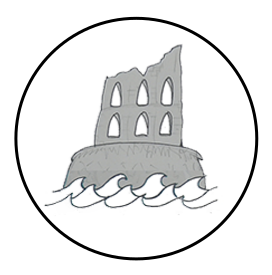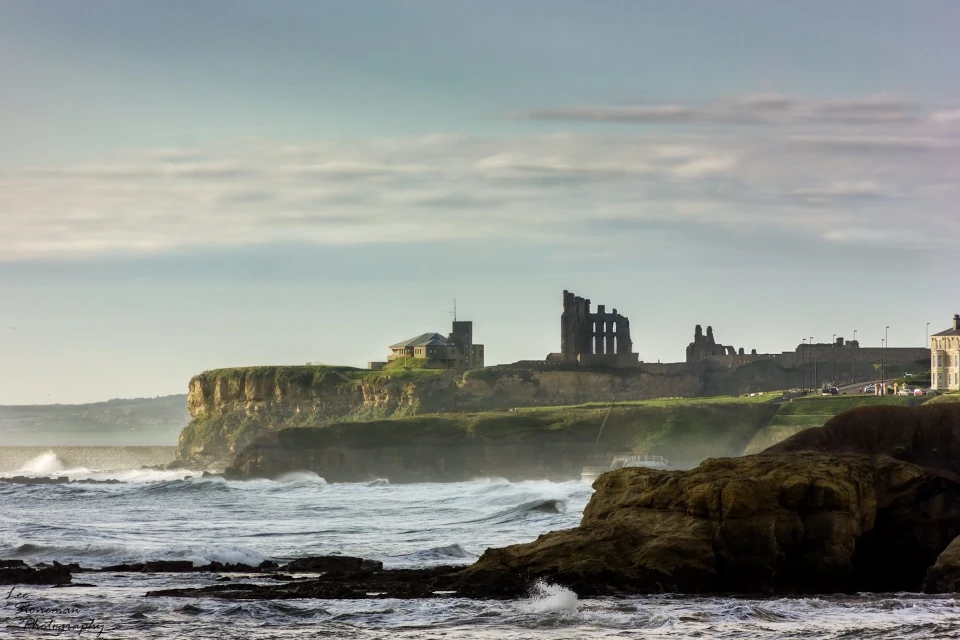History in Your Back Yard – Page 2
Choose a point on the map to watch a video
Wallsend
How Swan Hunter carried the torch in world shipbuilding during the golden age of ocean liners, by adopting Parson’s cutting edge turbine technology ![]()
Segedunum! The fort at the end of the Wall. Its branch wall led into the Tyne and had a statue of Hadrian on the end, possibly in the guise of Neptune ![]() I also describe a typical fort, the spiritual centre of which, in some ways is the origin of churches
I also describe a typical fort, the spiritual centre of which, in some ways is the origin of churches ![]()
Did you know that Newcastle was the original ‘Wallsend’ and Segedunum was added after the Wall was built? Standing on this reconstucted section, above the original, I explain why I think it was called ‘Segedunum’.
On the shore of the Tyne near the old lead works at Walker, we found this mystery carved stone. Who knows where it came from? An old manor house? 🗿
Ouseburn
This forgotten field in Byker, with its spectacular view across the city, is the site of Stanley Street, home of the original football club that would go on to become Newcastle United. Unbelievably, there is nothing here to commemorate it.
William Armstrong, and later the company Armstrong Whitworth, had deep business interests with Japan and most of Japan’s formidable battle fleet were built at Elswick in the late 19th & early 20th centuries. The former Ouseburn School, built in 1892, is a homage to his ties with the country.
Ballast Hills or ‘Plaguey Fields’ was the resting place of thousands of people until 1853 when it had to be closed following cholera outbreaks that caused a public health crisis in the city. There’s no church associated with it as it was reserved for religious dissenters.
Hadrian’s Wall ran right across the Ouseburn, from Shields Rd to Stepney Bank. Recently Turret 3A was found, which is bigger than other Wall turrets. It also sits at a strategic point rather than a standard distance from Milecastle 3, which was under Byker Bridge.
Jesmond
The story of King John’s Palace. No one really knows why it’s got the name, but it was the seat of Adam of Jesmond, a widely loathed Sheriff of Newcastle. When he failed to return from the Ninth Crusade, his house fell into disrepair, and today it stands as a ruin in Heaton Park.
St Mary’s Well, Jesmond, is as old as Newcastle itself. It was famous as a healing well akin to Lourdes, after an apparition there, probably caused by clouds of vapour on cold days. The yew tree next to it symbolises it’s pre-Christian origin, representing healing & protection 📿
St Mary’s Chapel, Jesmond, first mentioned in 1272, received pilgrims to the nearby shrine from all over the country. That made Pilgrim Street in Town a bustling hive of inns and alehouses catering to the rich & poor, able & infirm alike. Probably with quite a party feel to it.
Jesmond comes from ‘Ouse mound’ and earlier, ‘Ouse mouth’. But the oldest trees in Jesmond Dene are yew trees. A venerable clump of them sit here alongside the river. ‘Ouse’ may come from the root for water (see Gaelic: uis), but could it not mean ‘yews burn’ (Gaelic: iur)? ![]()
Town Moor
Newcastle is unique in having so much common land in the form of the Town Moor. Every town had a common for pasture and roaming, but these were sold off as urban centres grew. Through its preservation, we get a direct link going back to medieval times in the middle of the city.
St James’s Park may be the only city centre stadium in the world. This is because it was part of the Town Moor, and is still leased to the Club. But SJP is just one part of the sporting, cultural and historical legacy of the place.
The Civic Centre was commissioned by T Dan Smith, Newcastle’s great visionary. It contrasts the sandstone and brick buildings of the Town and is designed in the style of post-War idealism, when architects had a lot of freedom and big budgets to play with.
Grainger Town
Earl Grey is famous for his tea and for being Prime Minister, but he was lauded in his lifetime for his role in bringing democracy to the nation. At least, he began that long process. The public rewarded him with this monument, and you can’t get more pride of place than that.
Richard Grainger transformed Newcastle into one of the finest towns in the country architecturally. This is the story of his rise & fall and the project he built.
Mosley Street was originally the main the east-west thoroughfare in the Town, linking the Cloth Market and Pilgrim St. It was also the first street in the world to be lit by electricity, thanks to Joseph Swan’s genius 💡 (Previously lamps required the use of whale oil…)
The Lort Burn was an open sewer in medieval times (lort = ‘crap’ in Danish). It’s thought the earliest commercial activity in Newcastle centred around this tributary to the Tyne and Low Bridge Street, where I’m standing, was where Hadrian’s Wall crossed the burn.
Quayside
The ancient origin of Newcastle
The Swing Bridge is a symbol of Newcastle’s role as the most technologically advanced city in the world. That’s why we need it working again. It’s also the site of the original Roman Bridge, which stood for over 1000 years.
Trinity House were formed as a seafarers’ guild in Tudor times and have occupied the same piece of same land on the Quayside ever since. They have saved countless lives at sea and in their courtyard is an anchor from the Spanish Armada ⚓
All Saints is said to stand on the site of a Roman pantheon—a temple to all the gods (maybe that’s where the name ‘Pandon’ comes from). The 18thC church is a homage to that idea, with the only circular nave in Britain, an unsupported roof, two pediments and a columned facade 🏛️
The Holy Jesus Hospital has a long history, as it sat on the ancient route north along Pilgrim Street. It’s one of the only extant 17C buildings in town and would’ve been lost if it wasn’t for the influence of T Dan Smith on the City Council when the Central Motorway was built.
Daniel Defoe led an amazing life and lived in Gateshead from 1706-1710 to avoid his creditors while working as a spy and propagandist for the government. It’s said that he wrote Robinson Crusoe here and his accounts of the area are well worth a read 👀
My exasperated thoughts on the state of the Cooperage 🙈 100% of people in Newcastle want this saved. A crowdfunding effort would be overwhelming.
The High Level Bridge is the oldest iron bridge in the NE. It had to be made with iron as the river bed wouldn’t support an entirely stone bridge of this magnitude. It shows there was no limit to Stephenson’s genius, yet today we can’t even build high speed rail in the UK…
West Gate
From poverty, Robert Stephenson became the most celebrated Victorian engineer and built a global business empire including about 30% of the rail network in this country. And it all started here, just off Forth Street, Newcastle.
There’s a ton of history at St John the Baptist’s Church ✠ on Grainger Street, including in a window from 1375, the first depiction of Newcastle’s coat of arms of three silver castles on a red shield ♜♜♜
During the Middle Ages, Newcastle was said the have the best town walls in England, maybe even Europe… This is the history of them ⚔️
As it’s Black History Month, I’m in Summerhill talking about Frederick Douglass, the great anti-slavery campaigner who stayed here in 1846 with the Richardsons, who were famous Quakers and civil rights activists at the time.






